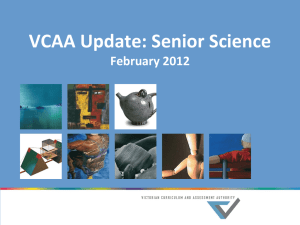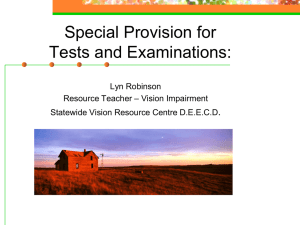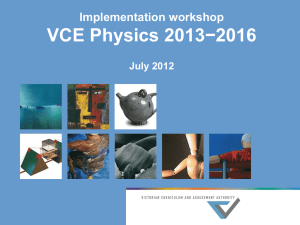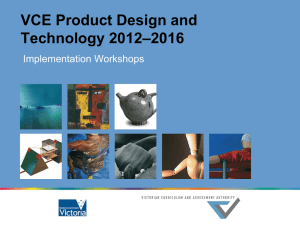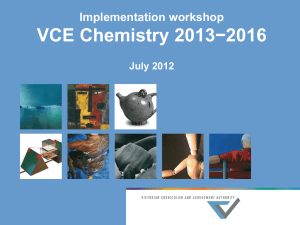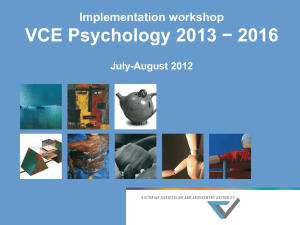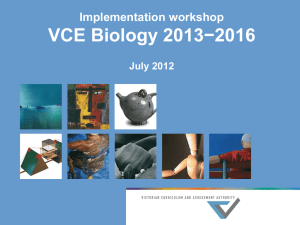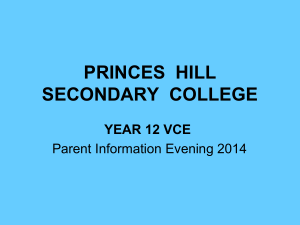VCE Visual Communication Design Assessment Handbook 2013
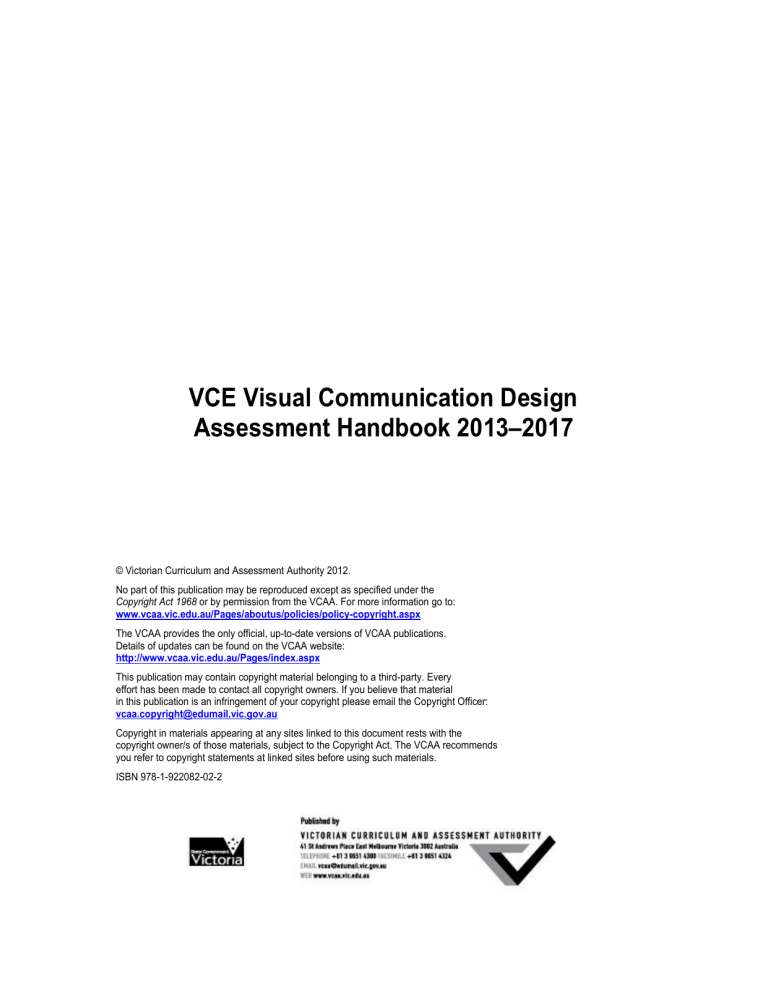
VCE Visual Communication Design
Assessment Handbook 2013–2017
© Victorian Curriculum and Assessment Authority 2012.
No part of this publication may be reproduced except as specified under the
Copyright Act 1968 or by permission from the VCAA. For more information go to: www.vcaa.vic.edu.au/Pages/aboutus/policies/policy-copyright.aspx
The VCAA provides the only official, up-to-date versions of VCAA publications.
Details of updates can be found on the VCAA website: http://www.vcaa.vic.edu.au/Pages/index.aspx
This publication may contain copyright material belonging to a third-party. Every effort has been made to contact all copyright owners. If you believe that material in this publication is an infringement of your copyright please email the Copyright Officer: vcaa.copyright@edumail.vic.gov.au
Copyright in materials appearing at any sites linked to this document rests with the copyright owner/s of those materials, subject to the Copyright Act. The VCAA recommends you refer to copyright statements at linked sites before using such materials.
ISBN 978-1-922082-02-2
Contents
Visual Communication Design Assessment Advice and Further Resources ..............................10
VCAA 200X
VCE Visual Communication Design ASSESSMENT HANDBOOK 2013–2017
Introduction
The VCE Visual Communication Design Assessment Handbook 2013–2017 contains assessment information for both school-based assessment and the examination in Visual
Communication Design and advice for teachers on how to construct assessment tasks. Advice on matters related to the administration of Victorian Certificate of Education (VCE) assessment is published annually in the VCE and VCAL Administrative Handbook . Updates to matters related to the administration of VCE assessment are published in the VCAA Bulletin
VCE, VCAL and VET . Teachers must refer to these publications for current advice.
This assessment handbook is published in online format only and provides advice specifically for Units 3 and 4.
Updates to the online assessment handbook are published in the VCAA Bulletin VCE, VCAL and VET .
Units 1 and 2
In Visual Communication Design the student’s level of achievement in Units 1 and 2 is a matter for school decision. Assessments of levels of achievement for these units are not to be reported to the Victorian Curriculum and Assessment Authority (VCAA). Schools may choose to report levels of achievement to students using grades, descriptive statements or other indicators.
Units 3 and 4
The VCAA will supervise the assessment of all students undertaking Units 3 and 4.
In Visual Communication Design the student’s level of achievement will be determined by
School-assessed Coursework, a School-assessed Task and an end-of-year examination. The
VCAA will report the student’s level of performance as a grade from A+ to E or UG (ungraded) for each of three Graded Assessment components: Unit 3 and 4 School-assessed Coursework,
Units 3 and 4 School-assessed Task and the end-of-year examination.
VCAA 2012 3
ASSESSMENT HANDBOOK 2013–2017 VCE Visual Communication Design
Assessment
VCE assessment principles
Assessment is an integral part of teaching and learning. At the senior secondary level it:
• identifies opportunities for further learning
• describes student achievement
• articulates and maintains standards
• provides the basis for the award of a certificate.
As part of VCE studies, assessment tasks enable:
• the demonstration of the achievement of an outcome or set of outcomes
• judgment and reporting of a level of achievement on a task or collection of tasks for
School-assessed Coursework, School-assessed Tasks or examinations.
Monitoring the results of VCE assessment also provides feedback that informs curriculum implementation, assessment design and curriculum review.
In each VCE study, teachers and schools determine the assessment tasks to be used at Units 1 and 2. In Units 3 and 4, specified assessment tasks are set.
At the Units 3 and 4 level of this VCE study, School-assessed Coursework, a School-assessed
Task and the examination provide assessment results that are used in the calculation of a student’s study score.
The following are the principles that underpin all VCE assessment practices. These are extracted from the VCAA Principles and guidelines for the development and review of VCE studies published as Supplement 1 to the March 2009 VCAA Bulletin VCE, VCAL and VET
No. 68.
VCE assessment will be valid
Validating of VCE assessment means that it will enable judgments to be made about demonstration of the outcomes and levels of achievement on assessment tasks fairly, in a balanced way and without adverse effects on the curriculum or the education system. The overarching concept of validity is elaborated as follows.
VCE assessment should be fair and reasonable
Assessment should be acceptable to stakeholders – including students, schools, government and the community. The system for assessing the progress and achievement of students must be accessible, effective, equitable, reasonable and transparent.
Assessment instruments should not assess learning that is outside the scope of a study design.
4 VCAA 2012
VCE Visual Communication Design ASSESSMENT HANDBOOK 2013–2017
Each assessment instrument (for example, examination, assignment, test, project, practical, oral, performance, portfolio, presentation or observational schedule) should give students clear instructions. It should be administered under conditions (degree of supervision, access to resources, notice and duration) that are substantially the same for all students undertaking that assessment.
VCE assessment should be equitable
Assessment instruments should neither privilege nor disadvantage certain groups of students or exclude others on the basis of gender, culture, linguistic background, physical disability, socioeconomic status and geographical location.
Assessment instruments should be designed so that, under the same or similar conditions, they provide consistent information about student performance. This may be the case when, for example, alternatives are offered at the same time for assessment of an outcome (which could be based on a choice of context) or at a different time due to a student’s absence.
VCE assessment will be balanced
The set of assessment instruments used in a VCE study will be designed to provide a range of opportunities for a student to demonstrate in different contexts and modes the knowledge, skills, understanding and capacities set out in the curriculum. This assessment will also provide the opportunity for students to demonstrate different levels of achievement specified by suitable criteria, descriptors, rubrics or marking schemes.
Judgment about student level of achievement should be based on the results from a variety of practical and theoretical situations and contexts relevant to a study. Students may be required to respond in written, oral, performance, product, folio, multimedia or other suitable modes as applicable to the distinctive nature of a study or group of related studies.
VCE assessment will be efficient
The minimum number of assessments for teachers and assessors to make a robust judgment about each student’s progress and learning will be set out in the study design. Each assessment instrument must balance the demands of precision with those of efficiency.
Assessment should not generate workload and/or stress that unduly diminish the performance of students under fair and reasonable circumstances.
VCAA 2012 5
ASSESSMENT HANDBOOK 2013–2017 VCE Visual Communication Design
School-assessed Coursework
School-assessed Coursework provides schools with the opportunity to make their own administrative arrangements for the internal assessment of their students.
School-assessed Coursework also provides teachers with the opportunity to:
• select from the range of designated assessment tasks in the study design
• develop and administer their own assessment program for their students
• monitor the progress and work of their students
• provide important feedback to the student
• gather information about the teaching program.
Students should know in advance how and when they are going to be assessed and the conditions under which they will be assessed.
Assessment tasks should be part of the teaching and learning program. For each assessment task students should be provided with the:
• type of assessment task and approximate date for completion
• time allowed for the task
• allocation of marks
• nature of any materials they can utilise when completing the task
• opportunity to demonstrate the highest level of performance.
Following an assessment task:
• teachers can use the performance of their students to evaluate the teaching and learning program
• a topic may need to be carefully revised again prior to the end of the unit to ensure students fully understand the key knowledge and key skills required in preparation for the examination.
Feedback provides students with important advice about which aspect or aspects of the key knowledge they need to learn and in which key skills they need more practice.
Authentication
Teachers should have in place strategies for ensuring that work submitted for assessment is the student’s own. Where aspects of School-assessed Coursework tasks are completed outside class time teachers must monitor and record each student’s progress through to completion.
This requires regular sightings of the work by the teacher and the keeping of records.
The teacher may consider it appropriate to ask the student to demonstrate his/her understanding of the task at the time of submission of the work. If any part of the work cannot be authenticated, then the matter should be dealt with as a breach of rules.
To reduce the possibility of authentication problems arising, or being difficult to resolve, the following strategies are useful:
•
Ensure that a significant amount of classroom time is spent on the task so that the teacher is familiar with each student’s work and can regularly monitor and discuss aspects of the work with the student.
•
Ensure that students document the specific development stages of work, starting with an early part of the task such as topic choice, list of resources and/or preliminary research.
•
Filing of copies of each student’s work at given stages in its development.
6 VCAA 2012
VCE Visual Communication Design ASSESSMENT HANDBOOK 2013–2017
•
Regular rotation of topics from year to year to ensure that students are unable to use student work from the previous year.
•
Where there is more than one class of a particular study in the school, the VCAA expects the school to apply internal moderation/cross-marking procedures to ensure consistency of assessment between teachers. Teachers are advised to apply the same approach to authentication and record-keeping, as cross-marking sometimes reveals possible breaches of authentication. Early liaison on topics, and sharing of draft student work between teachers, enables earlier identification of possible authentication problems and the implementation of appropriate action.
• Encourage students to acknowledge tutors, if they have them, and to discuss and show the work done with tutors. Ideally, liaison between the class teacher and the tutor can provide the maximum benefit for the student and ensure that the tutor is aware of the authentication requirements. Similar advice applies if students receive regular help from a family member.
• Use VCAA VCE Authentication record for School-assessed Coursework to identify work completed by students located through VASS forms at http://www.vcaa.vic.edu.au/Pages/schooladmin/forms/vce/vce.aspx
Scope of tasks
Assessment tasks must be a part of the regular teaching and learning program and must not unduly add to the workload associated with that program. They must be completed mainly in class and within a limited timeframe. Where there is a range of options in assessment tasks, teachers must ensure that they are comparable in scope and demand. Teachers should select a variety of assessment tasks for their program to reflect the key knowledge and key skills being assessed and to provide for different learning styles.
Designing the assessment tasks
Designing an assessment task is an important part of the teaching, learning and assessment process. The assessment task needs to provide the opportunity for all students to demonstrate the highest level of performance on the outcome. Teachers should design an assessment task that is representative of the content (key knowledge and key skills underpinning the outcome).
Performance descriptors for each outcome in Units 3 and 4 are provided to assist teachers in making a judgment about the student’s level of performance on the outcome.
The following information presents one approach to developing an assessment task.
Making assessment part of teaching and learning
Step 1: Define the parameters of an outcome and its related assessment task options.
This involves:
• Listing the key knowledge and key skills that will be assessed by the outcome. These are stated in the study design but may be reworded for student purposes.
• Choosing the assessment task from the options listed in the study design. It is possible for students in the same class to undertake different options; however, teachers must ensure that the tasks are comparable in scope and demand.
VCAA 2012 7
ASSESSMENT HANDBOOK 2013–2017 VCE Visual Communication Design
Step 2: Examine the assessment advice.
Examine the highest level of performance descriptors and clarify their meaning if unsure.
Use the study design as a reference point. Remember the performance descriptors for each outcome identify the qualities or characteristics that need to be identified in a student response. This helps in the development of the task. It also helps clarify what needs to be taught as well as what needs to be included in the assessment task. It will assist students in understanding the expectations of the task.
Step 3: Determine teaching and learning activities.
Identify the nature and sequence of teaching and learning activities to cover the key knowledge and key skills outlined in the study design. It is important that a variety of learning opportunities are provided to cater for individual preferred learning styles. (Refer to the
‘Advice for teachers’ section of the study design for some specific examples of learning activities for each outcome.)
Step 4: Design the assessment task.
• Try to use a range of task types across Units 3 and 4.
• The information in the stimulus should be relevant to the task and assist students in their response.
• Check that the instructions are clear. Are they complete and unambiguous?
Conditions for the task
•
It is important that students know what is expected of them in an assessment task. This means providing students with advice about the outcome’s key knowledge and key skills to be assessed. This allows students to understand during the teaching and learning stage what they are expected to know or do.
• Students should be provided with the performance descriptors by which their response will be assessed.
•
Students should be advised about the conditions under which they will be expected to do the task.
•
Teachers can develop their own rules, consistent with school policies, about the material that can be brought into the room and the use of textbooks. Make sure that these rules are given to the students before the task is started and preferably in writing.
•
One method of authentication is to collect the work at the end of each period and keep it in an individual plastic folder, workbook or folio.
Points to consider
When constructing a task consider the following:
•
Does the task enable students to demonstrate the highest possible performance level?
• Will students select the form of the response or will you select the form that the whole class will use?
•
Will the task be completed in one lesson or over several lessons? If the task is going to run over several lessons will the task be divided into parts or will students’ work be collected at the end of each lesson? If a school has multiple Visual Communication Design classes and a task is designed to last several lessons will the task be altered slightly for each class?
• Does the task allow easy identification of the key aspects of the response to be assessed?
8 VCAA 2012
VCE Visual Communication Design ASSESSMENT HANDBOOK 2013–2017
Visual Communication Design Assessment Advice and Further
Resources
School-assessed Coursework
Teachers will provide to the VCAA a score for each outcome in each of Units 3 and 4, which represents an assessment of the student’s achievement. The score must be based on the teacher’s assessment of the level of performance of each student on the outcomes for the unit specified in the study design. Teachers must select assessment tasks from the designated list for each outcome published in the study design.
Assessment tasks should be a part of the regular teaching and learning program and should not add unduly to student workload. Assessment tasks should be completed mainly in class and within a limited timeframe. The overall assessment program for the unit should include a variety of assessment task formats, include provision for authentication of student work and take into account the overall workload for students.
School-assessed Coursework for the outcomes in Unit 3 will contribute 20 per cent to the student’s study score for Visual Communication Design.
School-assessed Coursework for the outcomes in Unit 4 will contribute 5 per cent to the student’s study score for Visual Communication Design.
Performance descriptors
Performance descriptors provide holistic statements of achievement developed from the outcome statement and its key knowledge and key skills, as specified in the study design.
They provide guidance for the setting and marking of assessment tasks.
Unit 3 Area of Study 1 Outcome 1
On completion of this unit the student should be able to create visual communications for specific contexts, purposes and audiences that are informed by their analysis of existing visual communications.
This outcome will contribute 75 marks out of 100 marks allocated to School-assessed
Coursework for Unit 3. It will be assessed by two or more tasks, which will contribute a total of 75 marks.
VCAA 2012 9
ASSESSMENT HANDBOOK 2013–2017 VCE Visual Communication Design
Performance descriptors
The following descriptors provide a guide to the levels of performance typically demonstrated within each range on the assessment task/s.
MARK RANGE DESCRIPTOR: typical performance in each range
Part A: Explanation and analysis of existing visual communications
13–15 marks
10–12 marks
7–9 marks
5- 6 marks
Comprehensive and perceptive analysis of the features, purposes, contexts and audience/s of selected existing visual communications. Insightful evaluation of how materials, methods, media, design elements and principles are applied to convey information in existing visual communications. Highly developed evidence that effectively details the connections between existing visual communications and student work.
Highly effective use of terminology.
Detailed and clear analysis of the features, purposes, contexts and audience/s of selected existing visual communications. Clear evaluation of how materials, methods, media, design elements and principles are applied to convey information in existing visual communications. Well-developed evidence that details the connections between existing visual communications and student work. Effective use of terminology.
Satisfactory analysis of the features, purposes, contexts and audience/s of selected existing visual communications. Adequate evaluation of how materials, methods, media, design elements and principles are applied to convey information in existing visual communications. Satisfactory evidence that details the connections between existing visual communications and student work. Appropriate use of terminology.
Limited analysis of the features, purposes, contexts and audience/s of selected existing visual communications. Limited evaluation of how materials, methods, media, design elements and principles are applied to convey information in existing visual communications. Some evidence that details the connections between existing visual communications and student work. Limited use of terminology.
1–4 marks Very limited analysis of the features, purposes, contexts and audience/s of selected existing visual communications. Basic description of how materials, methods, media, design elements and principles are applied to convey information in existing visual communications. Very little evidence that details the connections between existing visual communications and student work. Very limited use of terminology.
Part B: Practice – creation of visual communications
49–60 marks Highly developed skills and accurate use of drawing methods and conventions to visualise ideas and concepts and to create visual communications. Highly effective selection and consistent application of design elements and principles, methods, materials and media to create visual communication for specific purposes, audiences and contexts.
Comprehensive knowledge and highly developed skills in the use of type, image and digital applications appropriate to specific visual communications.
10 VCAA 2012
VCE Visual Communication Design ASSESSMENT HANDBOOK 2013–2017
37–48 marks
25–36 marks
13–24 marks
1–12 marks
Well- developed skills and accurate use of drawing methods and conventions to visualise ideas and concepts and to create visual communications. Effective selection and generally consistent application of design elements and principles, methods, materials and media to create visual communication for specific purposes, audiences and contexts. Clear knowledge and well- developed skills in the use of type, image and digital applications appropriate to specific visual communications.
Adequate skills and accurate use of drawing methods and conventions to visualise ideas and concepts and to create visual communications.
Satisfactory selection and application of design elements and principles, methods, materials and media to create visual communication for specific purposes, audiences and contexts. Adequate knowledge and skills in the use of type, image and digital applications appropriate to specific visual communications.
Limited skills and some accurate use of drawing methods and conventions to visualise ideas and concepts and to create visual communications.
Limited selection and limited application of design elements and principles, methods, materials and media to create visual communication for specific purposes, audiences and contexts. Some knowledge and skills in the use of type, image and digital applications appropriate to specific visual communications.
Very limited skills and very little accurate use of drawing methods and conventions to visualise ideas and concepts and to create visual communications. Very limited selection and very little application of design elements and principles, methods, materials and media to create visual communication for specific purposes, audiences and contexts. Very little knowledge and very limited skills in the use of type, image and digital applications appropriate to specific visual communications.
Task/s
Description
In response to given stimulus material, create three visual communications designed for different contexts, purposes and audiences,
These visual communications will include evidence of:
• two- or three-dimensional presentation drawing
• use of digital methods. and
An explanation of the connections between each of these visual communications and existing visual communications using one of the following forms:
• annotated visual communications
• written or oral report supported by visual evidence.
Designing the assessment task/s
Teachers should develop assessment tasks that allow the student to:
• analyse existing visual communications from communication, environmental and industrial design fields in terms of their key features
• make and document design decisions that are informed by the analysis of existing visual
• communications
VCAA 2012 11
ASSESSMENT HANDBOOK 2013–2017 VCE Visual Communication Design
• select and apply two-dimensional and/or three dimensional drawing methods and drawing conventions appropriate to different purposes, audiences and contexts
• select and apply a range of design elements, design principles, manual and digital methods, materials, conventions and media appropriate to different purposes, audiences and contexts
• use appropriate terminology
• have the opportunity to demonstrate the highest level of performance.
Note: Students are not expected to demonstrate all two dimensional and three dimensional drawing methods and apply digital methods in each visual communication created; rather, they need a knowledge of each method to make appropriate applications as required by the different visual communications.
Resources and scheduling
Schools may determine the conditions for the task including access to resources and notes.
Students should be advised of the timeline and conditions under which the task is to be conducted.
Unit 3 Area of Study 2 Outcome 2
On completion of this unit the student should be able to describe how visual communications are designed and produced in the design industry and explain factors that influence these practices.
This outcome will contribute 25 marks out of 100 marks allocated to School-assessed
Coursework for Unit 3. It will be assessed by one or more tasks, which will contribute a total of 25 marks.
Performance descriptors
The following descriptors provide a guide to the levels of performance typically demonstrated within each range on the assessment task/s.
MARK RANGE
21–25 marks
16–20 marks
11–15 marks
DESCRIPTOR: typical performance in each range
Perceptive understanding of the processes and practices of visual communication design production. Thorough description of the roles, relationships and responsibilities between designers, specialists and clients. Insightful explanation of factors and influences on design decisions that impact the selection of materials, methods, media, design elements and principles. Comprehensive understanding of the legal obligations of designers. Highly effective use of terminology.
Thorough understanding of the processes and practices of visual communication design production. Detailed description of the roles, relationships and responsibilities between designers, specialists and clients. Clear explanation of factors and influences on design decisions that impact the selection of materials, methods, media, design elements and principles. Well-developed understanding of the legal obligations of designers. Effective use of terminology.
Satisfactory understanding of the processes and practices of visual communication design production. Appropriate description of the roles, relationships and responsibilities between designers, specialists and clients. Adequate explanation of factors and influences on design decisions that impact the selection of materials, methods, media, design elements and principles. Clear understanding of the legal obligations of
12 VCAA 2012
VCE Visual Communication Design ASSESSMENT HANDBOOK 2013–2017
6–10 marks
1–5 marks designers. Appropriate use of terminology.
Limited understanding of the processes and practices of visual communication design production. Basic description of the roles, relationships and responsibilities between designers, specialists and clients. Limited explanation of factors and influences on design decisions that impact the selection of materials, methods, media, design elements and principles. Some understanding of the legal obligations of designers.
Limited use of terminology.
Very limited understanding of the processes and practices of visual communication design production. Very limited description of the roles, relationships and responsibilities between designers, specialists and clients. Description of factors and influences on design decisions that impact the selection of materials, methods, media, design elements and principles. Very little understanding of the legal obligations of designers.
Very limited use of terminology.
Task/s
Description
Any one or combination of the following:
• a written report
• short and extended responses
• structured questions
• an annotated visual report.
Designing the assessment task/s
Teachers should develop assessment tasks that allow the student to:
• study key contemporary Australian and/or international designers from communication, environmental and/or industrial design fields
• distinguish key characteristics of different design fields
• describe stages of the design process used by visual communication designers
• describe the roles, responsibilities and relationships between the clients, designers and specialists
• describe the practices, techniques and processes used by designers in establishing briefs, pitching and presenting design proposals and in designing and producing visual communications that fulfil clients’ needs
• describe evaluation techniques employed by designers throughout the design and production of visual communications
• explain how design decisions including the choice of materials, methods, media, design elements and principles are influenced by a range of factors (social, ethical, financial and environmental)
• identify practices that acknowledge legal obligations of designers and clients with respect to ownership of intellectual property, trademarks and copyright
• use appropriate terminology
• have the opportunity to demonstrate the highest level of performance.
Resources and scheduling
Schools may determine the conditions for the task including access to resources and notes.
Students should be advised of the timeline and conditions under which the task is to be conducted.
VCAA 2012 13
ASSESSMENT HANDBOOK 2013–2017 VCE Visual Communication Design
Unit 4 Area of Study 3 Outcome 3
The student should be able to devise a pitch to present and explain their visual communications to an audience and evaluate the visual communications against the brief.
This outcome will contribute 20 marks out of the 20 marks allocated to School-assessed
Coursework for Unit 4. It will be assessed by one or more tasks, which will contribute a total of 20 marks.
Performance descriptors
The following descriptors provide a guide to the levels of performance typically demonstrated within each range on the assessment task/s.
MARK RANGE
17–20 marks
13–16 marks
9–12 marks
5–8 marks
1–4 marks
DESCRIPTOR: typical performance in each range
Highly developed pitch presented to the audience. Thorough explanation of how the final visual communications fulfill the requirements identified in the brief. Comprehensive explanation of the design thinking behind decisions made during the design process using detailed and appropriate terminology. Very detailed criteria and highly effective use of critical and reflective thinking strategies to evaluate the final presentations and design process.
Well-developed pitch presented to the audience. Clear explanation of how the final visual communications fulfill the requirements identified in the brief. Detailed explanation of the design thinking behind decisions made during the design process using detailed and appropriate terminology. Clearly stated criteria and effective use of critical and reflective thinking strategies to evaluate the final presentations and design process.
Satisfactory pitch presented to the audience. Adequate explanation of how the final visual communications fulfill the requirements identified in the brief. Appropriate explanation of the design thinking behind decisions made during the design process using appropriate terminology.
Adequate criteria developed and satisfactory use of critical and reflective thinking strategies to evaluate the final presentations and design process.
Limited pitch presented to the audience. Some explanation of how the final visual communications fulfill the requirements identified in the brief. Little explanation of the design thinking behind decisions made during the design process using some appropriate terminology. Limited criteria developed and some use of critical and reflective thinking strategies to evaluate the final presentations and design process.
Very limited pitch presented to the audience. Very limited explanation of how the final visual communications fulfill the requirements identified in the brief. Very basic description of the design thinking behind decisions made during the design process using limited terminology. Very limited criteria developed to evaluate the final presentations and design process.
Task/s
Description
Any one or combination of the following:
• a written report
• an annotated visual report
14 VCAA 2012
VCE Visual Communication Design ASSESSMENT HANDBOOK 2013–2017
• an oral presentation.
Designing the assessment task/s
Teachers should develop assessment tasks that allow the student to:
• understand the purpose and components of a pitch
• devise and deliver a pitch that supports the presentation of final visual communications
• present final visual communications that satisfy the brief
• explain the design thinking behind each of the visual communication presentations
• apply criteria for evaluating the quality of the final presentations
• evaluate the design process as a framework for creating visual communications
• use appropriate terminology.
Resources and scheduling
Schools may determine the conditions for the task including access to resources and notes.
Students should be advised of the timeline and conditions under which the task is to be conducted.
VCAA 2012 15
ASSESSMENT HANDBOOK 2013–2017 VCE Visual Communication Design
School-assessed Task
Units 3 and 4
The School-assessed Task contributes 40 per cent to the study score and is commenced in
Unit 3 and completed in Unit 4.
Outcomes
Unit 3
Outcome 3
Apply design thinking skills in preparing a brief, undertaking research and generating a range of ideas relevant to the brief.
Unit 4
Outcome 1
Develop distinctly different design concepts for each need, and select and refine for each need a concept that satisfies each of the requirements of the brief.
Unit 4
Outcome 2
Produce final visual communication presentations that satisfy the requirements of the brief.
Assessment tasks
A brief that identifies the contexts, constraints, client’s needs and target audience, and a folio generating ideas relevant to the brief.
The development folio for each need will include evidence of:
• use of design process and design thinking strategies
• annotated research for information and inspiration
• observational and visualisation drawings
• generation of a wide range of design ideas.
A folio of conceptual developments for each need. The conceptual development folio for each need will include evidence of:
• use of design process and design thinking strategies
• application of manual and digital methods, media, materials, design elements, design principles, presentation formats
• development and refinement of concepts
• reasons for selection of preferred concepts for each need
Two distinct final presentations in two separate presentation formats that fulfil the communication needs of the client as detailed in the brief developed in Unit 3.
Teachers will provide to the VCAA a single score representing an assessment of the student’s level of performance in achieving Outcome 3 in Unit 3 and Outcome 1 and Outcome 2 in
Unit 4. The score must be based on the teacher’s assessment of the student’s performance according to the criteria published each year in the VCAA Bulletin VCE, VCAL and VET
‘Administrative advice for school-based assessment’ supplement .
The set of criteria for the award of grades is the sole basis for the assessment of the School-assessed Task. This assessment will be subject to review by a panel appointed by the VCAA. The completed assessment sheet for each student’s School-assessed Task must be available on request by the
VCAA.
Details of authentication requirements and administrative arrangements for the Schoolassessed Task will be published annually in the VCAA Bulletin VCE, VCAL and VET ‘ Advice for School assessment ’ supplement, and the current year’s VCE and VCAL Administrative
Handbook .
16 VCAA 2012
VCE Visual Communication Design ASSESSMENT HANDBOOK 2013–2017
Sample approaches to School-assessed Coursework
The following examples are one teacher’s approach to the development of assessment tasks using the study design and performance descriptors.
Unit 3
Outcome 1
The student should be able to create visual communications for specific contexts, purposes and audiences that are informed by their analysis of existing visual communications.
Step 1: Define the parameters of an outcome and its related assessment task options.
The VCE Visual Communication Design Study Design , pages 23 and 24, provides details of the key knowledge and key skills related to Unit 3 Outcome 1 and the Area of Study 1:
Analysis and practice in context. In order to plan and conduct an assessment for this outcome it is necessary to be familiar with the key knowledge and key skills. Teachers should design an assessment task that is representative of the content (key knowledge and key skills underpinning the outcome). The study design identifies a range of task formats that can be used to assess this outcome.
Step 2: Examine the assessment advice.
The performance descriptors should be fully understood as they give a clear indication of qualities and characteristics that you are looking for in a student response. For example, there is a need for explanation and analysis regarding how the selected stimulus material informs or has inspired the student’s own drawings and visual communications. Therefore the selection of existing visual communications for analysis is important. One approach could be that teachers source suitable examples that provide opportunities for detailed analysis and multiple starting points of interest for the practical investigation, or that they provide feedback regarding suitability to students regarding materials prior to starting the assessment task.
Step 3: Determine teaching and learning activities.
The assessment task for Unit 3 Outcome 1 states:
In response to given stimulus material, students create three visual communications designed for different contexts, purposes and audiences. These visual communications will include evidence of:
• two- or three-dimensional presentation drawing
• use of digital methods.
And
An explanation of the connections between each of these visual communications and existing visual communications using one of the following forms:
• annotated visual communications
• written or oral report supported by visual evidence.
The teacher plans a sequence of teaching and learning activities that will develop pre-task knowledge and skills providing resources, models and exemplars to enable students to understand the conventions associated with each of the two-dimensional and threedimensional drawing methods and how they are applied in the different contexts of communication, industrial and environmental design fields.
Students will need to develop an understanding of the analysis and application of design elements, design principles and methods, media and materials. The development of knowledge and skills in the use of suitable digital applications for the design and production of visual communications will also be important.
VCAA 2012 17
ASSESSMENT HANDBOOK 2013–2017 VCE Visual Communication Design
Teaching the pre-task knowledge and skills
Use the key knowledge and key skills to be learnt in Unit 3 Outcome 1 and ensure that students:
• analyse existing visual communications in terms of their key features
• make and document design decisions that are informed by the analysis of existing visual
• communications
• select and apply two-dimensional and/or three dimensional drawing methods and drawing conventions appropriate to different purposes, audiences and contexts
• select and apply a range of design elements, design principles, manual and digital methods, materials, conventions and media appropriate to different purposes, audiences and contexts
• use appropriate terminology.
In relation to Unit 3 Outcome 1, an approach to the teaching and learning activities is as follows:
•
Collect a wide variety of existing visual communications and sort into various categories such as:
– communication, environmental and industrial design,
– techniques for targeting particular audiences
– similar purpose
– highlight use of a particular design element and/or design principle,
– specific methods, media and materials
– presentation formats and/or contexts
This can be done as a group activity and displayed around the classroom. Discussion about reasons for choices regarding categories can provide a useful means to understand the definition for each category. Students can also make their own collections.
• Create a mind map of each existing visual communication for analysis in order to categorise information, establish links and connections and brainstorm possible starting points for student’s own visual communications
•
Create glossaries of key terminology
• Quick visualisation exercises: select existing visual communications such as magazine advertisements or brochures which contain imagery of products / buildings / structures.
Ask students to make quick freehand sketches using isometric, planometric and perspective to draw the object and to visualise what it might look like from behind, above, in use, put to another use, combined with another object.
• Students look at isometric, planometric and perspective drawings of products and reinterpret as orthogonal drawings and vice versa. Students look at packaging nets and draw the resulting three dimensional form and vice versa.
• Stimulus materials in the form of products such as chairs, kitchen equipment or toys are brought into the classroom. Students identify the methods, media, materials used in the design and production and speculate why designers chose these options, what problems did they solve? Students make quick freehand three-dimensional drawings from different angles and two dimensional drawings of the back, front, side views. They measure the object and consider what scale would be appropriate for an orthogonal drawing.
18 VCAA 2012
VCE Visual Communication Design ASSESSMENT HANDBOOK 2013–2017
Step 4: Design the assessment task.
Analysis:
Written analysis of stimulus material (can be one or more existing visual communications)
Students prepare a written report analysing the key features, purpose, audience and use of design elements, design principles, methods, media and materials. They consider and plan possible connections, avenues for inspiration or starting points for the creation of their own visual communications. They establish the purpose, context and audience for their three visual communications. They explore techniques they could use to attract the same/different target audience; designing for a different purpose; adapt to another context; change the hierarchy of information; emphasize a different design principle through use of particular design elements; investigate the impact on the imagery if other methods, media and materials are used.
Practice:
Students create three visual communications in response to stimulus material (can be one or more existing visual communications). This will involve designing for a new purpose
AND/OR attract a new or different audience AND/OR translate to a different context. The purpose, context and audience is identified prior to creating the three visual communications.
Examples could include:
•
Environmental: students select from two-dimensional and three-dimensional drawing methods to create a rendered perspective drawing OR set of elevations to match existing floor, OR planometric based on existing floor plan OR create new landscape design for existing site. Students use digital and/or manual methods.
•
Industrial: students select from two-dimensional and three-dimensional drawing methods to create, for example, a rendered isometric drawing OR dimensioned third angle orthogonal drawing, perspective drawing of product in context
•
Communication: examples could include: use part of existing contents and translate to different presentation format or context (eg change from brochure to a billboard), reinterpret imagery using a different method, material and media, use humour to attract a different target audience
Over the three visual communications, there must be evidence of the selection of appropriate two-dimensional and three-dimensional drawing methods and the use of digital methods.
(Not all three visual communications have to contain all of these aspects).
Marking the task
The performance descriptors can be adapted into a marking scheme, which should be explained to students before starting the task.
The task should provide students with a question or questions that relate directly to the key knowledge and key skills and it should provide the opportunity to meet the standard reflected in the highest performance descriptor for the task.
This task is worth 75 marks towards the total marks allocated to School-assessed Coursework for Unit 3. A possible breakdown of marks could be:
VCAA 2012 19
ASSESSMENT HANDBOOK 2013–2017 VCE Visual Communication Design
Assessment of analysis task:
Identification and description of features, purpose, target audience, context of existing communications and those proposed for student’s own visual communications.
(5 marks)
Analysis of design elements and design principles of existing communications and possible ideas for their use in student’s own work.
(5 marks)
Analysis of methods, materials, media and conventions used in existing communications and discussion of possibilities for application in student’s own works.
(5 marks)
Assessment of three visual communications:
Visualisation drawings: quick drawings with annotations which make informal use of drawing methods to visualise ideas.
(10 marks)
Conventions: accuracy in use of selected two-dimensional and threedimensional drawing methods, symbols, lines, dimensions (if appropriate), proportions maintained. (Note, not all 3 visual communications need to incorporate conventional drawing methods)
(10 marks)
Ability to select and apply appropriate methods, media and materials.
Ability to select and apply design elements and principles. Consideration of layout for type and imagery.
(10 marks)
Use of digital methods (Note, digital methods do not have to be used in all three visual communications)
(10 marks)
(10 marks)
Extent to which final visual communications meet stated purpose, target audience and context
(10 marks)
Other considerations
When to assess the students
The teacher must decide the most appropriate time to set this task. This decision is the result of several considerations including:
• the estimated time it will take to cover the key knowledge and key skills for the outcome
• the possible need to provide a practice, indicative task
• the likely length of time required for students to complete the task
• when tasks are being conducted in other subjects and the workload implications for students.
The analysis task is likely to be provided around weeks 3 or 4 of Term 1. The task might only require one or two 50-minute sessions (if two sessions, then perhaps a double period) and the exact date and time can be decided in consultation with students, the VCE coordinator/s and other key staff. The practical tasks could be completed / submitted every two-three weeks (for example in weeks 5, 7 and 9, Term 1) or submitted together at the end of Area of Study 1.
20 VCAA 2012
VCE Visual Communication Design ASSESSMENT HANDBOOK 2013–2017
Unit 3
Outcome 2
On completion of this unit the student should be able to describe how visual communications are designed and produced in the design industry and explain factors that influence these practices.
Step 1: Define the parameters of an outcome and its related assessment task options.
The VCE Visual Communication Design Study Design , page 25, provides details of the key knowledge and key skills related to Unit 3 Outcome 2 and the Area of Study 2: Design industry practice. In order to plan and conduct an assessment for this outcome it is necessary to be familiar with the key knowledge and key skills. Teachers should design an assessment task that is representative of the content (key knowledge and key skills underpinning the outcome). The study design identifies a range of task formats that can be used to assess this outcome.
Step 2: Examine the assessment advice.
The performance descriptors should be fully understood as they give a clear indication of qualities and characteristics that you are looking for in a student response. For example, there is a need to examine more than one designer in order for students to gain an appreciation of the range of design fields and knowledge of international and Australian designers.
Step 3: Determine teaching and learning activities.
One assessment task option for Unit 3 Outcome 2 is structured questions.
The teacher plans a sequence of teaching and learning activities that will develop pre-task knowledge and skills related to the work practices of international and Australian designers.
Teaching the pre-task knowledge and skills
Use the key knowledge and key skills to be learnt in Unit 3 Outcome 2 and ensure that students:
• study key contemporary Australian and/or international designers from communication, environmental and/or industrial design fields
• can distinguish key characteristics of different design fields
• can describe stages of the design process used by visual communication designers
• can describe the roles, responsibilities and relationships between the clients, designers and specialists
• can describe the practices, techniques and processes used by designers in establishing briefs, pitching and presenting design proposals and in designing and producing visual communications that fulfil clients’ needs
• can describe evaluation techniques employed by designers throughout the design and production of visual communications
• can explain how design decisions including the choice of materials, methods, media, design elements and principles are influenced by a range of factors (social, ethical, financial and environmental)
• can identify practices that acknowledge legal obligations of designers and clients with respect to ownership of intellectual property, trademarks and copyright
In relation to Unit 3 Outcome 2, teaching and learning activities could involve:
VCAA 2012 21
ASSESSMENT HANDBOOK 2013–2017 VCE Visual Communication Design
• undertaking a visit to a design studio; so students can see firsthand designers in an industry setting
• interviewing designers about their relationship with the client and specialists, use of a design process, presenting and pitching techniques, management of intellectual property
• contacting designers and asking about how they present and evaluate their designs
• students sharing / presenting findings about different designers with each other to broaden their understanding of international and Australian designers in a range of design fields
• a speaker addressing students; for example, at the Season of Excellence Top Designs
Student Forums at the Melbourne Museum so students can learn about the work of a particular designer who works in the design industry, or a school community member who works in the design industry
• reading appropriate case studies and learning about what factors influence their design decisions regarding methods, materials and media, design elements and principles
• viewing and discussing multimedia regarding design industry practice, case studies of projects
• gathering information regarding copyright, trademarks and intellectual property by visiting websites such as www.copyright.org.au/find-an-answer/ , www.ipaustralia.gov.au/ ,
Make your Mark IP Design Victoria Publication 2011 www.business.vic.gov.au/busvicwr/_assets/main/lib60053/nov10_make_your_mark.pdf
.
Step 4: Design the assessment task.
•
Students are required to answer a series of structured questions requiring short and extended answers relating to design industry practice based upon the designers that students have researched and studied. Some questions would relate to designers not studied directly, thereby asking them to apply the knowledge gained from their study of individual designers to new situations.
Marking the task
The performance descriptors can be adapted into a marking scheme, which should be explained to students before starting the task.
The task should provide students with a question or questions that relate directly to the key knowledge and key skills and it should provide the opportunity to meet the standard reflected in the highest performance descriptor for the task.
This task is worth 25 marks towards the total marks allocated to School-assessed Coursework for Unit 3. A possible breakdown of marks could be:
International and/or Australian design industry characteristics of communication, environmental and industrial design fields
(5 marks)
(5 marks) Roles, responsibilities, relationships of the client, designer and specialists.
Practices and use of design process; establishing brief, research, presenting and evaluating ideas, design proposals, final presentations.
(5 marks)
Basis of design decisions about methods, materials, media, design elements and principles and influence of social, ethical, financial and environmental factors
(5 marks)
Legal obligations of designers with regards to intellectual property, copyright and trademarks
(5 marks)
22 VCAA 2012
VCE Visual Communication Design ASSESSMENT HANDBOOK 2013–2017
Other considerations
When to assess the students
The teacher must decide the most appropriate time to set this task. This decision is the result of several considerations including:
• the estimated time it will take to cover the key knowledge and key skills for the outcome
• the possible need to provide a practice, indicative task
• the likely length of time required for students to complete the task
• when tasks are being conducted in other subjects and the workload implications for students.
The task should be provided at the end of Area of Study 2. This is likely to be around weeks 3 or 4 of Term 2. The task might only require one or two 50-minute sessions (if two sessions, then perhaps a double period) and the exact date and time can be decided in consultation with students, the VCE coordinator/s and other key staff.
VCAA 2012 23
ASSESSMENT HANDBOOK 2013–2017 VCE Visual Communication Design
Unit 4
Outcome 3
The student should be able to devise a pitch to present and explain their visual communications to an audience and evaluate the visual communications against the brief.
Step 1: Define the parameters of an outcome and its related assessment task options.
The VCE Visual Communication Design Study Design , pages 31 and 32, provides details of the key knowledge and key skills related to Unit 4 Outcome 3 and the Area of Study:
Evaluation and explanation. In order to plan and conduct an assessment for this outcome it is necessary to be familiar with the key knowledge and key skills. Teachers should design an assessment task that is representative of the content (key knowledge and key skills underpinning the outcome). The study design identifies a range of task formats that can be used to assess this outcome.
The study design identifies a range of task formats that can be used to assess this outcome.
Teachers should be familiar with the essential characteristics of each task type and the implications of these for task design and conduct of assessment.
Step 2: Examine the assessment advice.
The performance descriptors should be fully understood as they give a clear indication of qualities and characteristics that you are looking for in a student response. For example, a response for this outcome would need to explain the design thinking behind each of the final presentations and how they fulfill the brief.
Step 3: Determining teaching and learning activities.
One assessment task option for Unit 4 Outcome 3 is an oral presentation.
The teacher plans a sequence of teaching and learning activities that will develop pre-task knowledge and skills in ways of evaluating their work and presenting information in a clear manner which maintains the audience’s attention.
Teaching the pre-task knowledge and skills
Use the key knowledge and key skills to be learnt in Unit 4 Outcome 3 and ensure that students:
• understand the purpose and relevant components of a pitch
• consider various methods of delivering a pitch to present and explain resolutions to a brief
• develop criteria for evaluating the extent to which final presentations met the requirements of the brief
• develop criteria for evaluating how the design process was used as a framework for creating visual communications
• apply critical and reflective thinking strategies
• use terminology appropriate to the study.
In relation to Unit 4 Outcome 3, teaching and learning activities could involve:
• researching existing examples of pitching and presenting by designers
• class discussions on what makes a successful pitch and possible techniques for presenting visual materials including final presentations
• collection of data from testing and evaluating final presentations
• gathering of feedback from focus group involving target audience
24 VCAA 2012
VCE Visual Communication Design ASSESSMENT HANDBOOK 2013–2017
• review of brief and development folio to gather evidence of the use of creative, critical and reflective thinking strategies
• working in pairs to practise explaining concepts and design thinking.
Step 4: Design the assessment task.
Students are to present their final presentations to an audience (this may be to a single audience member, fellow students, members of the school community, visitors such as practicing designers or the client). They will describe how they evaluated the finals against the brief and explain their thinking behind the decisions made. The presentation may involve the use of visual materials other than the final presentations.
Marking the task
The performance descriptors can be adapted into a marking scheme, which should be explained to students before starting the task.
The task should offer a question or questions that relate directly to the key knowledge and key skills and provides the opportunity to meet the standard reflected in the highest performance descriptor for the task.
This task is worth 20 marks towards the total marks allocated to School-assessed Coursework for Unit 4. A possible breakdown of marks could be:
Quality of the pitch and presentation of the final visual communications (5 marks)
Explanation of how final presentations fulfill the brief
Use of appropriate techniques to evaluate the final presentations and design process.
(5 marks)
Explanation of design thinking used to make decisions regarding methods, materials, media, design elements and principles used in final presentations.
(5 marks)
(5 marks)
Other considerations
When to assess the students
The teacher must decide the most appropriate time to set this task. This decision is the result of several considerations including:
• the estimated time it will take to cover the key knowledge and key skills for the outcome
• when tasks are being conducted in other subjects and the workload implications for students.
The presentation should be completed at the end of Area of Study 3. This is likely to be around weeks 9 and 10 of Semester 2. (This will allow examination revision time.) The task might require one to two 50-minute sessions, depending upon the manner of presentation and number of students. The exact dates and times can be decided in consultation with students,
VCE coordinator/s and other key staff.
VCAA 2012 25
ASSESSMENT HANDBOOK 2013–2017 VCE Visual Communication Design
Further Resources
Examination
End-of-year written examination – Units 3 and 4
Description
The examination will be set by a panel appointed by the VCAA. All the key knowledge and key skills that underpin the outcomes in Units 3 and 4 are examinable.
Conditions
•
Duration: one and a half hours.
•
Date: end-of-year, on a date to be published annually by the VCAA.
•
VCAA examination rules will apply. Details of these rules are published annually in the
VCE and VCAL Administrative Handbook .
•
The examination will be marked by assessors appointed by the VCAA.
Contribution to the final assessment
The examination will contribute 35 per cent.
Further advice
The VCAA publishes specifications for all VCE examinations on the VCAA website.
Examination specifications include details about the sections of the examination, their weighting, the question format/s and any other essential information. The specifications are published in the first year of implementation for the revised Units 3 and 4 sequence together with any sample materials.
VCE Examination Papers
Examination papers for all studies are published on the VCAA website.
Assessment Reports
The assessment reports are published on the VCAA website and provide teachers with feedback on the examination for Units 3 and 4.
Publications
Regular updates and study advice are published in the VCAA Bulletin VCE, VCAL and VET and on the VCAA website. Teachers should also refer to the following publications for assessment of VCE Visual Communication Design:
VCE Visual Communication Design Study Design 2013–2017
The course developed and delivered to students must be in accordance with the VCE Visual
Communication Design Study Design , accredited 2013–2017.
The ‘Advice for teachers’ section contains sample learning activities for Units 1 to 4 and suggested tasks.
26 VCAA 2012
VCE Visual Communication Design ASSESSMENT HANDBOOK 2013–2017
VCE Visual Communication Design 2013–2017 Resources
Teachers are advised to use the resources list in conjunction with the ‘Advice for teachers’ section of the VCE Visual Communication Design Study Design . The resources list is published online and will be updated annually.
VCAA website
Teachers are advised to keep up-to-date with developments in VCE Visual Communication
Design by accessing the Visual Communication Design study page on the VCAA website.
Administrative Procedures for Assessment in VCE Studies
This online publication provides summary information about assessment procedures for VCE studies http://www.vcaa.vic.edu.au/Pages/vce/generaladvice/index.aspx
. The information is extracted from the current VCE and VCAL Administrative Handbook .
VCAA 2012 27
